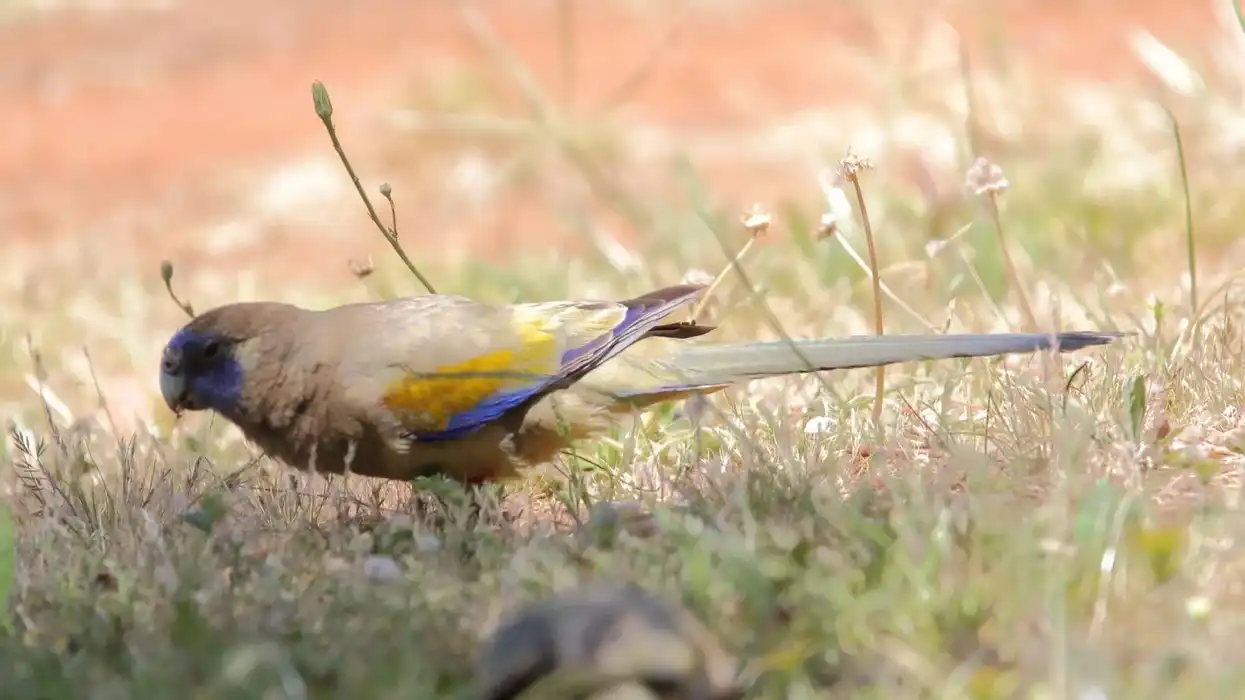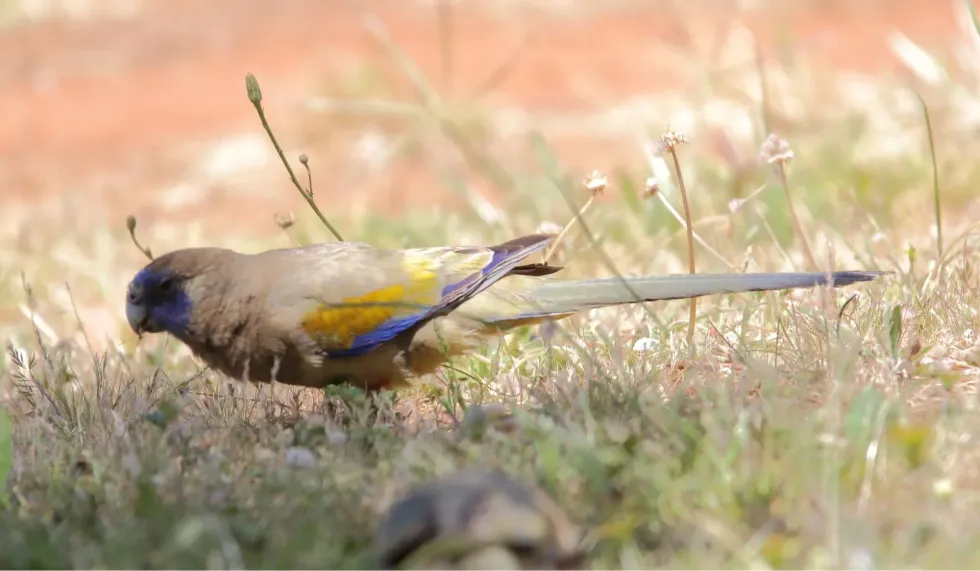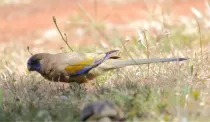Fun Blue Bonnet Parrot Facts For Kids

The blue bonnet is a type of Australian parrot found in the southern parts of Australia. They are also known by some other common names like the bluebonnet, crimson-bellied parakeet, red-vented parrot, and yellow vented parrot in their native region.
These medium-sized social parrots live in small groups and they mate for life with their respective partners. The gray feathers with red or yellow patches make the parrot distinct from other parrots.
Although at present they belong to the Northeilla genus, they were originally included in the genus Psephotus and named Psephotus narethae at the time of discovery. However, due to their behavioral differences from the other members of the Psephotus genus they were given their own genus name.
The Northeilla genus consists of two subspecies, the greater bluebonnet (Northiella haematogaster) and the Naretha blue bonnet (Northiella narethae).
They can be identified from each other by some variation in their physical description and regional geography. If you are interested to learn more about the blue bonnet parrot, check out some of our fascinating facts about this bird.
For similar content, check out cockatoo facts and Senegal parrot facts too.
Blue Bonnet parrot Interesting Facts
What type of animal is a blue bonnet parrot?
A blue bonnet parrot is a type of medium-sized parrot endemic to the southern and western parts of Australia. They are also known as bluebonnets, crimson-bellied parakeets, red-vented parrost, and yellow vented parrots.
What class of animal does a blue bonnet parrot belong to?
The blue bonnet parrot, of Psittaciformes order and Psittaculidae family, belongs to the class Aves, the common class for all birds.
How many blue bonnet parrots are there in the world?
The total population of blue bonnet parrots has not been quantified yet. However, it is believed that the greater blue bonnets (Northiella haematogaster) have a big global population and are fairly common throughout their range.
Although their population does not face any immediate threat, excessive habitat exploitation, and uncontrolled felling of trees, has started to affect their population in a negative manner. In few places, like at the edges of the range of the greater blue bonnets, their numbers have already started to decline due to unsustainable living conditions.
On the other hand, the Naretha parrots (Northiella narethae) have been highly ignored in this aspect.
There is hardly any information regarding the global population range about this species of bluebonnet parrots. Since the 20th century, the Naretha bluebonnet is considered to be a rare species.
Where does a blue bonnet parrot live?
Endemic to Australia, the range of the species of blue bonnet parrot extends from the southeast of West Australia to the southwest of South Australia. Apart from certain differences in their physical description, the two groups of bluebonnets can be also be set apart by the differences in their ranges.
The eastern bluebonnet is found in the remote areas of the south and southeastern parts of Central Australia.
Their range extends from the arid inland region of southern Queensland to the southwestern parts passing through New South Wales and north-west Victoria.
The eastern bluebonnets are categorized into three distinct subspecies and each subspecies inhabits different regions. The subspecies Northiella haematogaster haematogaster is distributed throughout southern and western New South Wales and it extends up to southeast South Australia.
Northiella haematogaster haematorrhous and Northiella haematogaster pallescens nest respectively in southern Queensland and northern New South Wales, and in the Lake Eyre Basin. The species of Naretha bluebonnets are found up to the borders of South and West Australia.
They are fairly common in the dry Nullarbor region of the Australian Bight Coast.
What is a blue bonnet parrot's habitat?
The ideal habitat of the blue bonnets in the wild is believed to be arid and semi-arid forests. They also nest in low shrubs like saltbush dominated by scattered trees, open woodlands with trees like mulga, pine, and myall, and perennial shrubs.
Some populations reside in open grasslands with few trees, on trees by the side of various water bodies, and even in dry sand dune areas. The bluebonnet parrot species of the southern range and northwest Victoria are found by the roadside in sparse patches of mallee and partly in clear farmlands.
The bluebonnets, especially the Naretha species nest in myall woodlands in the wild.
These woodlands are mainly dominated by trees like acacias and eucalyptus. Breeding takes place in tree crevices or on the limbs of a tree.
Who do blue bonnet parrots live with?
Blue bonnets are social birds that live in small groups consisting of five or more birds. They forage together and nest on tree trunks during the non-breeding season.
In the breeding season, the pairs generally separate from the group to go to their breeding ground. They rejoin their group with their young ones after the mating season is over in late spring. Almost all groups disperse during the mating season and the birds only live in pairs in the breeding ground.
How long does a blue bonnet parrot live?
The average lifespan of a blue bonnet parrot is 8-10 years. Although these birds are rarely seen in captivity, experts have confirmed that the lifespan of the captive breeds is generally longer than the birds of the wild. In comparison, mealy parrots can live for up to 80 years
How do they reproduce?
Blue bonnets form monogamous pairs and mate for life. The birds fly to their mating ground in the winter and breed between January and August.
They follow an elaborate mating ritual before copulating. The males raise and lower their crests and elongate the necks to attract the females towards them.
They also start vibrating their wings while raising them partly and move the tail from one side to another. Once the females are wooed by the males, the pairs start copulating quickly.
Generally, they breed once in a single season, however, in cases of abundant rainfall, the blue bonnets are observed to mate up to two times in a season. The male and female both take part in building the nest to lay eggs.
They lay around four to seven eggs in a single clutch on a layer of decaying materials that provide protection to the eggs. After an incubation period of 19 days, the eggs finally hatch and the young ones emerge from it.
What is their conservation status?
The greater bluebonnets are classified as a species of Least Concern in the IUCN Red List. They have an extremely large range and are commonly observed in their habitat.
This has prevented them from entering the threshold of endangered species although they are following a decreasing population trend. Some common threats that have slowly started to affect the bird population are illegal trapping of the bird, destruction of their habitats, and excessive tree cutting.
Blue Bonnet Parrot Fun Facts
What does a blue bonnet parrot look like?

The greater blue bonnets (Northiella haematogaster) are a species of medium sized parrot with showy forecrown feathers on the head. The color of the upper body ranges from olive-gray to brown.
The neck and the breast of the bird are also olive-gray in color. The subspecies residing in distinct areas are recognized by variation in their physical description and differences in plumage.
For example, Northiella haematogaster haematorrhous are known as red-vented blue bonnets because of their red under tail feathers, while Northiella haematogaster haematogaster are referred to as yellow-vented blue bonnets.
The yellow vented parrot has less red and more yellow feathers on the lower body. Northiella haematogaster pallescens have duller plumage with respect to the other subspecies.
The outer wing and the wing-edges appear dark blue while the head and the forehead are a shade lighter than the wing color. The upper wing of the bluebonnet has an olive-yellow patch.
Their bill has a beautiful mystic gray tinge to it which makes them look very unique.
The adult females have duller plumage than the males and some of them also have white bands on the lower feathers of the body. The chicks are duller than the adult birds with a light red patch on the belly and they have a brownish-orange bill.
The Naretha species of bluebonnet is slightly smaller in size than the greater bluebonnet. They are distinguished from the greater ones by their red wing feathers and diffused spots on the breast.
How cute are they?
The bluebonnets look different than other parrots. While they are not as colorful as Amazon parrots, the combination of the gray-toned and red plumage makes them look unique and cute.
How do they communicate?
The bluebonnet mainly communicates by vocalizations. They have a harsh and loud chak-chak call which helps them to communicate with each other.
How big is a blue bonnet parrot?
The length of a blue bonnet parrot ranges between 10.2-13.8 in (26-35 cm). They are one and a half times bigger in size than peach-faced lovebirds.
How fast can a blue bonnet parrot fly?
Blue bonnets are known to be quick flyers however their exact speed has not been determined. They fly with a long and quick gait.
How much does a blue bonnet parrot weigh?
The weight of a blue bonnet parrot ranges between 2.5-3.5 oz (70.8-99.2 g).
What are the male and female names of the species?
The male and the female blue bonnets are referred to as cocks and hens respectively.
What would you call a baby blue bonnet parrot?
Baby blue bonnets are referred to as chicks.
What do they eat?
Like hooded parrots, blue bonnets also have an omnivorous diet. They feed on seeds of grasses, shrubs, and plant matter. They also feed on fruits, berries, flowers, seeds from saltbush, and nectar. Apart from seeds and fruit, they sometimes feed on insects and their larvae. Adding insects and larvae to their diet acts as a source of protein.
Are they dangerous?
Blue bonnets are extremely aggressive and therefore cannot be tamed. It is better to avoid these birds as they tend to attack anyone that interacts with them.
Would they make a good pet?
Parrots are regarded as popular cage birds all over the world, but blue bonnets are not recommended as good pets. They are commonly observed in the wild because, in captivity, these parrots are often considered to be aggressive, noisy, and dull.
Did you know...
The bluebonnet chicks fly from the nest after one month since the eggs hatch but their parents continue to feed them for 12 days. It is considered that it takes them 12 days to mature completely after leaving the nest.
Are there bluebonnets in Australia?
Blue bonnets, also known as crimson-bellied parakeets, are found all over south and southwest Australia. They are an endemic species of the region.
Does the blue bonnet parrot migrate?
Blue bonnets are generally residential and mostly sedentary species that do not show large-scale seasonal migration. Sometimes they are found to migrate within a local area.
Here at Kidadl, we have carefully created lots of interesting family-friendly animal facts for everyone to discover! For more relatable content, check out these bowerbird facts and umbrellabird facts for kids.
You can even occupy yourself at home by coloring in one of our free printable blue headed parrot coloring pages.
We Want Your Photos!
More for You
See All
Bachelor of Arts specializing in Journalism and Mass Communication, Postgraduate Diploma in Sports Management

Moumita DuttaBachelor of Arts specializing in Journalism and Mass Communication, Postgraduate Diploma in Sports Management
A content writer and editor with a passion for sports, Moumita has honed her skills in producing compelling match reports and stories about sporting heroes. She holds a degree in Journalism and Mass Communication from the Indian Institute of Social Welfare and Business Management, Calcutta University, alongside a postgraduate diploma in Sports Management.
Postgraduate Diploma in Management

Sakshi RaturiPostgraduate Diploma in Management
Sakshi has experience in marketing strategy, social media planning, and recruiting industry experts for capstone projects, she has displayed a commitment to enhancing their skills and knowledge. She has won multiple awards, including a Certificate of Appreciation for Creative Writing and a Certificate of Merit for Immaculate Turut, and is always seeking new opportunities to grow and develop.
Disclaimer
1) Kidadl is independent and to make our service free to you the reader we are supported by advertising. We hope you love our recommendations for products and services! What we suggest is selected independently by the Kidadl team. If you purchase using the Buy Now button we may earn a small commission. This does not influence our choices. Prices are correct and items are available at the time the article was published but we cannot guarantee that on the time of reading. Please note that Kidadl is a participant in the Amazon Services LLC Associates Program, an affiliate advertising program designed to provide a means for sites to earn advertising fees by advertising and linking to Amazon. We also link to other websites, but are not responsible for their content.
2) At Kidadl, we strive to recommend the very best activities and events. We will always aim to give you accurate information at the date of publication - however, information does change, so it’s important you do your own research, double-check and make the decision that is right for your family. We recognise that not all activities and ideas are appropriate for all children and families or in all circumstances. Our recommended activities are based on age but these are a guide. We recommend that these ideas are used as inspiration, that ideas are undertaken with appropriate adult supervision, and that each adult uses their own discretion and knowledge of their children to consider the safety and suitability. Kidadl cannot accept liability for the execution of these ideas, and parental supervision is advised at all times, as safety is paramount. Anyone using the information provided by Kidadl does so at their own risk and we can not accept liability if things go wrong.
3) Because we are an educational resource, we have quotes and facts about a range of historical and modern figures. We do not endorse the actions of or rhetoric of all the people included in these collections, but we think they are important for growing minds to learn about under the guidance of parents or guardians.







